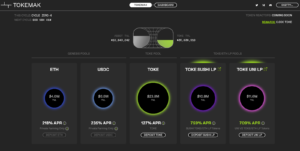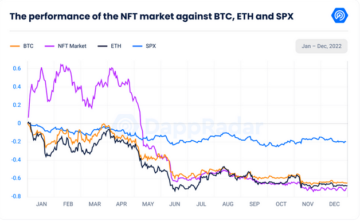Proto-Danksharding Could Boost Throughput Of Layer 2 Rollups By 100x
All eyes may be on Ethereum’s forthcoming transition to Proof-of-Stake consensus, but there is a lesser-known upgrade that’s set to cut Ethereum’s transaction costs, improving scalability – unlike the so-called Merge.
EIP-4844 upgrade is set to introduce ‘proto-danksharding’ alongside the next Ethereum fork following The Merge, which is tipped to boost the scalability of Layer 2 rollups by up to 100 times while paving the way for full sharding to be implemented.
This is ket, as Ethereum’s current roadmap is banking the network’s burgeoning Layer 2 ecosystem will handle scalability and fee mitigation, until sharding is implemented further down the track. Sharding will split Ethereum’s computational load across an ecosystem of small chains working in parallel, with Layer 2 chains expected to become the network’s shards in the future.
According to L2fees, simple token transfers cost roughly $0.1 on Ethereum’s leading rollup networks, with swaps estimated at around $0.15. But this isn’t good enough, says Vitalik Buterin, Ethereum’s co-founder and chief scientist, who tweeted in May that transaction fees on L2 must be below $0.05 “to be truly acceptable.”
The Merge, which is set to go live in mid-September, will usher in a more than 99% reduction in the network’s energy consumption and a roughly 90% drop in new Ether issuance. But many in the community are mistakenly anticipating that the upgrade will bring a significant increase in Ethereum’s scalability and a reduction in network fees.
Tim Beiko, the protocol development coordinator at Ethereum Foundation, told The Defiant that proto-danksharding is expected to go live between six and nine months after The Merge. However, he noted that “upgrade timelines are notoriously hard to predict” and that EIP-4844 will need to pass through governance before being implemented.
Sharding and Proto-Danksharding
Proto-danksharding gets its name from Dankrad Feist of the Ethereum Foundation. Feist designed danksharding, the current version of sharding that is slated to be introduced as part of Ethereum’s scaling roadmap.
Proto-danksharding is the first of Ethereum’s two-part process to introduce sharding. It will implement the majority of infrastructure for sharding prior to the network actually becoming sharded. This will include the transaction formats, verifications rules, consensus and execution logic, and gas price adjustments included in the Danksharding specifications.
Full danksharding is also tipped to further improve Ethereum’s scalability by an order of magnitude once implemented in two to three years time.
With danksharding, each validator only has to download a small portion of the block, allowing blocksize and throughput to increase by roughly 100 times in the context rollups compared to today.
Rollups have emerged as Ethereum’s leading Layer 2 scaling solution and are being implemented by the likes of Arbitrum, Optimism, and Polygon. They work by bundling together transactions executed on a low-cost Layer 2 network, which are then submitted in batches for validation on Ethereum’s base layer to significantly reduce transaction fees.
Mofi Taiwo, an engineer at OP Labs, the team behind Optimism, told The Defiant that “from L2s and other applications’ perspective, the user experience of proto-danksharding is the same as with full sharding.”
“This allows Ethereum to offer a complete data availability solution for rollups while full sharding is being developed, lowering their costs dramatically,” he added.
Replacing Calldata With Blobs
Buterin co-authored the EIP-4844 proposal with other Ethereum researchers in late February, roughly one week after the first proto-danksharding prototype was developed at the ETHDenver hackathon.
Proto-danksharding will allow transactions to carry “blobs” in place of calldata. Blobs are much smaller and cheaper for the network to process than the calldata it will replace.
Diederik Loerakker, a researcher at Ethereum Foundation and OP Labs, tweeted that “data blobs are the first milestone towards full Ethereum sharding, enabling rollups… to grow 100x in capacity.” Buterin wrote that the upgrade will result in “large scalability gains because this data is not competing with the gas usage of existing Ethereum transactions.”
Deleting Historical Data
Historical data will also be deleted from the network after 30 days once EIP-4844 takes effect. “The purpose of the Ethereum consensus protocol is not to guarantee storage of all historical data forever,” wrote Buterin. “Rather, the purpose is to provide a highly secure real-time bulletin board, and leave room for other decentralized protocols to do longer-term storage.”
The removal of the need to store historical data is one of the key features of EIP-4844 that will drive an increase in the scalability of rollups.
“Rollups… generate a lot of data which they need to post back to L1, and proto-danksharding provides them with a cheaper way to do this,” Taiwo said. “This design is especially well-suited for rollups because they don’t need permanent storage, but rather a strong guarantee that the data has been available on the Ethereum network for a specific amount of time.”
Buterin said that erasing historic data only poses risks to individual applications, not the Ethereum protocol itself. “It makes sense for applications to take on the burden of storing data relevant to themselves,” he said. “Block explorers, API providers, and other data services will likely store the full history.”
In a recent appearance on The Defiant podcast, Justin Drake, a researcher at the Ethereum Foundation, described the need for every validator to download the entire Ethereum blockchain as “redundant work.”
Looking Ahead
Taiwo noted that the number of rollups utilizing EIP-4844 will impact the scalability gains realized when proto-danksharding goes live.
“More rollups taking advantage of EIP-4844 will increase competition for blob space on the network, but fees will still be significantly reduced as opposed to a network without the scaling benefits of proto-danksharding,” he said.
- Bitcoin
- blockchain
- blockchain compliance
- blockchain conference
- coinbase
- coingenius
- Consensus
- crypto conference
- crypto mining
- cryptocurrency
- decentralized
- DeFi
- Digital Assets
- ethereum
- machine learning
- non fungible token
- plato
- plato ai
- Plato Data Intelligence
- Platoblockchain
- PlatoData
- platogaming
- Polygon
- proof of stake
- The Defiant
- W3
- zephyrnet









